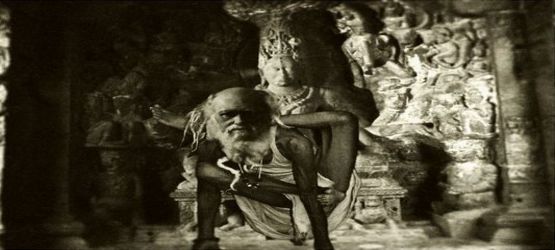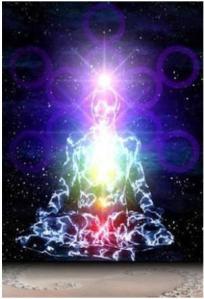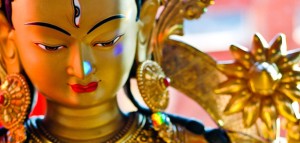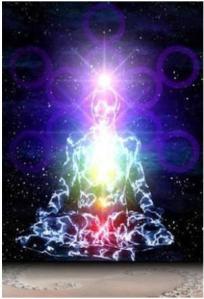The Purpose Of Attaining Spiritual Powers Some people out there promote yoga as some kind of health treatment/training exercise. Although it can, in fact, make you healthy, you’re only wasting time and money on these people if that’s the only thing they teach you about yoga.In order for you to fully grasp what this whole spiritual power enterprise is all about, you must first place yourself from the standpoint of the student of yoga. Other than that, you might get confused with some of the terms used in Hindu philosophy, so it's better that you become acquainted with them first. With that said, kindly take the time to carefully study the articles below:
How Spiritual Powers Are Developed The siddhis are the result of birth, drugs, mantras, austerities, or Samadhi. Our attention should be on Samadhi, but let me try to explain all of them briefly.
Awakening of Kundalini |
| Since Kundalini is the cosmic energy that originates from the Supramental Consciousness, it is an omniscient force, which enables the Yoga practitioner to realize his true self. Once this self-realization is achieved, the Yoga practitioner is led to Moksha, the final liberation from worldly existence and its attendant miseries. There is a close link between Kundalini and an intricate network of 72,000 Nadis, vein-like structures that exists in the whole of the human body. Three of these Nadis are like arterial ways that spiral upwards from the base of the spinal column all the way to the roof the brain, calledSahasrara. The middle artery, also considered the major pathway, is known as Sushumana. The other two arteries on either side ofSushumana are called Ida and Pingala. Six Chakras and three Granthis — consciousness centers or cosmic energy hubs are located vertically above one another at brief intervals in Sushumana. This entire network of Nadis, Chakras and Granthis exists in another dimension not known to science, in so subtle a form that no high-tech laboratory gadgets can ever detect its presence. However, when Kundalini is awakened through chanting of Guru Siyag's divine mantra and meditation, it rises through Sushumana to reach Sahasrara, its final destination where its master — Param Shiva — the eternal supramental consciousness resides. As it spirals upwards through Sushumana, the Kundalini energizes the whole network of ‘Nadis' and pierces theChakras one by one. The awakened Kundalini gets connected directly to the Supramental Consciousness through the Sushumana pathway. As a result of this, every pore and cell in the human body is purified and purged of its bodily and mental afflictions, making the Yoga practitioner energized and ready for the onward spiritual journey. The outward manifestations of this cleansing process are Yogic Kriyas or involuntary body movements that occur during Siddha Yoga meditation. Swaying from side to side, rapid movement of the head, clapping and uncoordinated movement of hands are some of the most typical of these Kriyas. To an untrained or uninitiated observer, these may look bizarre or even alarming. But they are neither abnormal nor do they cause any bodily harm. Kundalini, being an all-knowing energy force, is aware of which body part or organ is in acute need of healing or cleansing. So, the Kundalini makes the practitioner perform Kriyas that are specific to his needs. With this cleansing, the practitioner is cured of all kinds of chronic and even terminal diseases such as HIV, AIDS, cancer, arthritis etc., and genetic disorders like hemophilia, mental afflictions too are completely cured and stress is completely relieved. Also, the piercing of different consciousness centers equips the practitioner with Siddhis (powers) such as increased intuition, the ability to see unlimited past and future and perceive the existence of worlds beyond the physical one that we live in. When the Kundalini reaches Sahasrahara, the practitioner's spiritual journey is complete as it is here that he realizes his true self. This realization releases him from the bondage of Karmas, which are the root cause of all human miseries. It is also here that the seeker realizes that he is himself the Brahma, the eternal Supramental Consciousness, the state which also known as Moksha. However, Kundalini cannot be awakened by merely reading yoga books or by following a yoga trainer's instructions. The very central purpose of Yoga is to promote spiritual evolution of human race. |
OSHO"S VIGYAN BHAIRAV TANTRA FOR MEDITAT
question : lie down as dead. enraged in wrath, stay so. or stare without moving an eyelash. or suck something and become the sucking.
answer : LIE DOWN AS DEAD. Try it: suddenly you have gone dead. Leave the body! Do not move it, because you are dead. Just imagine that you are dead. You cannot move the body, you cannot move the eyes, you cannot cry, you cannot scream, you cannot do anything, you are just dead. And then feel how it feels. But do not deceive. You can deceive — you can slightly move the body. Do not move. If some mosquito is there, then treat the body as if it is dead. It is one of the most used techniques. Raman Maharshi attained his enlightenment through this technique, but it was not a technique used by him in his life. In his life it suddenly happened, spontaneously. But he must have persisted with this in some past life, because nothing happens spontaneously. Everything has a causal link, a causality. Suddenly one night Raman felt — he was just young, fourteen or fifteen at the time — that he was going to die. And it was so certain in his mind that death had taken over. He couldn’t move his body, he felt as if he was paralyzed. Then he felt a sudden choking, and he knew that now the heart was going to stop. He could not even cry and say to another, “I am going to die.” Sometimes it happens in some nightmare — you cannot cry, you cannot move. Even when you become awake for a few moments you cannot do anything. That happened. He had absolute power over his consciousness, but no power over his body. He knew he was there, that he was present, conscious, alert, but he felt he was going to die. And the knowledge became so certain that there was no other possibility, so he just gave up. He closed his eyes and remained there, just waiting to die; he waited there just to die. By and by the body became stiff. The body died, but then it became a problem. He knew that the body had died, but he was there and he knew it. He knew that he was alive and that the body had died. Then he came back. In the morning the body became okay but the same man never returned — because he had known death. He had known a different realm, a different dimension of consciousness. He escaped from the house. That death experience changed him completely. He became one of the very few enlightened persons of this age. This is the technique. This happened spontaneously to Raman, but it is not going to happen spontaneously to you. But try it. In some life it may become spontaneous. It may happen while you are trying it. And if it is not going to happen, the effort is never wasted. It is in you; it remains in you as a seed. Sometime, when the time is ripe and the rains will fall, it will sprout. Every spontaneity is just like this. The seed was sown some time ago, but the time was not ripe; there were no rains. In another life the time becomes ripe. You are more mature, more experienced, more frustrated with the world — then suddenly, in a certain situation, there are rains and the seed explodes. LIE DOWN AS DEAD. ENRAGED IN WRATH, STAY SO

Meditations
Meditation practice opens us up to the world, and allows us to realize fully what we are feeling as we encounter both suffering and joy. The Buddha taught the doctrine of the "Middle Way," a path that avoids extremes and remains centered in the reality of the present moment.
Brahma-Viharas
Brahma-Viharas is a Pali word (original language of the Buddha) meaning "heavenly abode" or "best home." The Buddha taught that practicing these four qualities leads to the "liberation of the heart which is love." The Brahma-Viharas are:
| Metta (lovingkindness) translates both as friendship and also gentle, as in a gentle rain that falls indiscriminately upon everything. Metta practice is a steady, unconditional sense of connection that touches all beings without exception, including ourselves. The Buddha first taught it as an antidote to fear. | |
| Compassion is our caring human response to suffering. A compassionate heart is non-judgmental and recognizes all suffering—our own and that of others—as deserving of tenderness. | |
| Sympathetic Joy is the realization that others’ happiness is inseparable from our own. We rejoice in the joy of others and are not threatened by another’s success. | |
| Equanimity is the spacious stillness of mind that provides the ground for the boundless nature of the other three qualities. This radiant calm enables us to ride the waves of our experience without getting lost in our reactions. |
Vipassana
Vipassana meditation quiets the mind and refines our awareness so we can directly experience the truth of our lives with a minimum of distraction and obscuration. This style traces directly to the way the Buddha himself practiced, and is common to all Buddhist traditions. Simplicity, stillness and attention are its qualities.
DAKINI POWER
Extraordinary Women Shaping the Transmission of Buddhism in the West
Dakini (Sanskrit): A female messenger of wisdom"The dakinis are the most important elements of the enlightened feminine in Tibetan Buddhism," says American teacher Tsultrim Allione.[iv] "They are the luminous, subtle, spiritual energy, the key, the gatekeeper, the guardian of the unconditioned state. If we are not willing to invite the dakini into our life, then we cannot enter these subtle states of mind. Sometimes the dakinis appear as messengers, sometimes as guides, and sometimes as protectors."
The Himalayas were always a nursery for highly accomplished female practitioners and to some extent still are. The yoginis might live in remote hermitages or nunneries as devoted practitioners, or as the wives, mothers, or daughters of famous teachers. Students often sought their advice informally, but women rarely wrote books, sat on high thrones or assumed lofty titles of their own. "There were certainly many great female practitioners in Tibet," says Tenzin Palmo. "But because they lacked a background of philosophical training, they could not aspire to write books, gather disciples, go on Dharma tours, and give talks. When we read the histories, we will notice that nuns are distinguished by their absence. But this doesn’t mean they weren’t there."[i]
While iconic archetypes of feminine enlightenment were erected on shrines, few women in Tibet were actually emboldened to follow in their footsteps. Despite the encouraging quote of the pioneer of Tibetan Buddhism that women’s potential to attain liberation is supreme, most Buddhist cultures throughout the centuries perceived women as lesser beings. The few encouraging statements are outnumbered by plenty of passages in the writings attributed to Padmasambhava and other masters that lament the hardships of womanhood. Commonly used Tibetan words for woman, lümen or kyemen, literally mean "inferior being" or "lesser birth." Some orthodox masters doubt to this day if women can attain realization at all, and age-old liturgies have women pray for a better rebirth in a male body.

SPIRITUAL GYM.
________________________________________
Live a Mega Life
The Concept Similar to a physical gym, this involves workout for inner balance.
Similar to a fitness trainer here we have Guru/ Spiritual Coach
Key Themes:
◦ Unifying mind, body and spirit
◦ Physical and Spiritual healing
◦ Health, happiness and prosperity
◦ Mega Living
In the initial stages there will be program modules/different types of sadhnas. Modules will be of different levels and spread over a period of time. Like the physical fitness gym model, users can take up subscriptions to various programs at the spiritual gym.
There can be different offerings like:
◦ 3 full day program module
◦ Spiritual workshops every Sunday for 2-3 hours
◦ Related spiritual material/accessories
We can tie up with spiritual tour organizers for people from foreign nationalities. Like the regular outbound corporate training programs, we can design spiritual corporate tours and outings.
We can further touch base with rich academic institutions and provide spiritual training to bulk students
How do we deliver these programs?
Any or both of the two options can be chosen:
◦ Out of a city based location:
This helps get people who are working to come and join on a weekend basis
◦ Outside City(Rishikesh/Haridwar):
This attracts foreigners most. River, natural conditional give it a distinct
look and feel. Also better for corporate spiritual tour programs
Personalized programs:
◦ Individual assessment
Pre-Assessments
Post-Assessments
Clear results (Physical pain removal etc.) :
Helps give the user clear tangible benefits
Broader results (Happiness, Peace etc.) :
Intangible benefits make the program unique
Like you get a fitness report in gym, something
like a ‘spiritual report’ is created.







0 comments:
Post a Comment